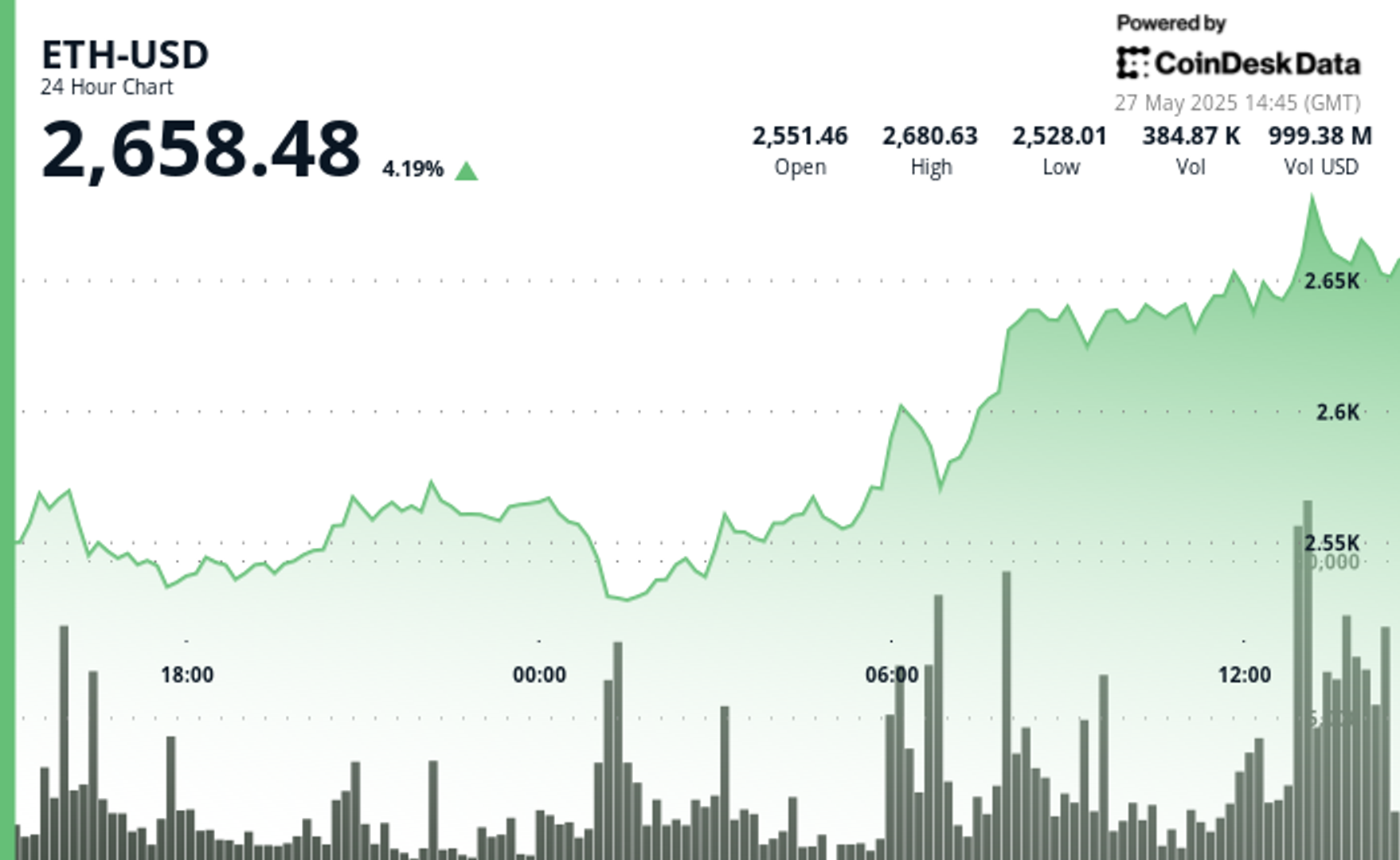Uncategorized
Record $14B Bitcoin Options Expiry Looms as Market Looks Highly Levered-Up

Just when you thought the year-end couldn’t get any more intriguing, a significant options expiry is set to shake things up in this highly levered-up market.
Options are derivative contracts that give the purchaser the right to buy or sell the underlying asset at a preset price at a later date. A call gives the right to buy, and a put confers the right to sell.
On Friday at 8:00 UTC, 146,000 bitcoin options contracts, valued at nearly $14 billion and sized at one BTC each, will expire on the crypto exchange Deribit. The notional amount represents 44% of the total open interest for all BTC options across different maturities, marking the largest expiry event ever on Deribit.
ETH options worth $3.84 billion will expire as well. ETH has dropped nearly 12% to $3,400 since the Fed meeting. Deribit accounts for over 80% of the global crypto options market.
Significant OI to expire ITM
As of writing, Friday’s settlement looked set to see $4 billion worth of BTC options, representing 28% of the total open interest of $14 billion, expire «in the money (ITM),» generating a profit for buyers. These positions may be squared off or rolled over (shifted) to the next expiry, potentially causing market volatility.
«I suspect a fair bit of open interest in BTC and ETH will be rolled into Jan. 31 and Mar. 28 expiries as the nearest liquidity anchors at the start of the new year,» Simranjeet Singh, portfolio manager and trader, at GSR said.
It should also be noted that the put-call open interest ratio for Friday’s expiry is 0.69, meaning seven put options are open for every 10 calls outstanding. A relatively higher open interest in calls, which provides an asymmetric upside to the buyer, indicates that leverage is skewed to the upside.
The issue, however, is that BTC’s bullish momentum has run out of steam since last Wednesday’s Fed decision, where Chairman Jerome Powell ruled out potential Fed purchases of the cryptocurrency while signaling fewer rate cuts for 2025.
BTC has since dropped over 10% to $95,000, according to CoinDesk indices data.
This means that traders with leveraged bullish bets are at risk of magnified losses. If they decide to throw in the towel and exit their positions, it could lead to more volatility.
«The previously dominant bullish momentum has stalled, leaving the market highly leveraged to the upside. This positioning increases the risk of a rapid snowball effect if a significant downside move occurs,» Deribit’s Chief Executive Officer Luuk Strijers told CoinDesk.
«All eyes are on this expiry, as it has the potential to shape the narrative heading into the new year,» Strijers added.
Directional uncertainty lingers
Key options-based metrics show there’s a noticeable lack of clarity in the market regarding potential price movements as the record expiry nears.
«The much-anticipated annual expiry is poised to conclude a remarkable year for the bulls. However, directional uncertainty lingers, highlighted by heightened volatility of volatility (vol-of-vol),» Strijers said.
The volatility of volatility (vol-of-vol) is a measure of fluctuations in the volatility of an asset. In other words, it measures how much the volatility or the degree of price turbulence in the asset itself fluctuates. If an asset’s volatility changes significantly over time, it has a high vol-of-vol.
A high vol-of-vol typically means increased sensitivity to news and economic data, leading to rapid changes in asset prices, necessitating aggressive position adjustment and hedging.
Market more bearish on ETH
How options due for expiry are currently priced reveals a more bearish outlook for ETH relative to BTC.
«Comparing the vol smiles of the [Friday’s] expiration between today and yesterday, we see that BTC’s smile is almost unmoved, while ETH’s implied vol of calls has dropped significantly,» Andrew Melville, research analyst at Block Scholes.
A volatility smile is a graphical representation of the implied volatility of options with the same expiration date but different strike prices. The drop in implied volatility for ETH calls means decreased demand for bullish bets, indicating a subdued outlook for Ethereum’s native token.
That’s also evident from the options skew, which measures how much investors are willing to pay for calls offering an asymmetric upside potential versus puts.
«After more than a week of poorer spot performance, ETH’s put-call skew ratio is more strongly bearish (2.06% in favour of puts compared to a more neutral 1.64% towards calls for BTC),» Melville noted.
Overall, end-of-year positioning reflects a moderately less bullish picture than we saw going into December, but even more starkly for ETH than BTC,» Melville added.
Uncategorized
Can Bitcoin Break Conference Curse at This Week’s Las Vegas Event?

As bitcoin BTC enters this week’s Bitcoin Conference in Las Vegas priced at roughly a record high above $109,000, traders and analysts are closely watching whether it what’s become a trend of poor performance after these events.
Historical data compiled by Galaxy Research across five prior conferences from San Francisco in 2019 to Nashville in 2024 reveals that bitcoin has generally fared poorly both during and especially after these gatherings.
For example, the 2019 event saw a 10% decline during the conference and BTC went on to tumble 24% over the following month. The 2022 conference in Miami showed a similar trajectory: down 1% during the event and a steep 29% slide in the month after. Both of those instances, however, occurred in the middle of bear markets.
Even in bull market years like 2023, though, price action remained flat or slightly negative.
The most recent 2024 conference in Nashville in July — which featured then-presidential candidate Donald Trump promising a strategic bitcoin reserve — posted a 4% gain during the event, but a fast 20% decline shortly after, coinciding with the unwinding of the yen carry trade that triggered a broader risk-off move across global markets.
The setup this year — which is set to feature current Vice President J.D. Vance — could be materially different as institutional engagement is rising. Still, with historical data stacked against it, bitcoin faces a psychological hurdle as much as a technical one. Conference weeks have become sell-the-news moments.

Uncategorized
Ethereum Surges 4% on Massive Volume as Institutional Interest Grows

Ethereum ETH has staged an impressive recovery in the past 24 hours, climbing 3.8% amid significant market volatility. The second-largest cryptocurrency found solid support at $2,530, where exceptional trading volume (242,521 ETH) created a clear bottoming pattern.
This was followed by a decisive breakout during the early trading hours, supported by massive volume surges exceeding 550,000 ETH that pushed prices above key resistance levels.
The recent price action confirms a short-term trend reversal, with ETH now trading above $2,575 after establishing new local highs. Institutional interest remains robust, with spot Ethereum ETFs recording $248 million in total net inflows over the past week, suggesting growing confidence from larger investors despite relatively subdued retail participation.
Market analysts point to the $2,800 level as a critical resistance zone where many investors who previously bought at that level may look to exit at break-even. However, with ETH breaking out of its recent consolidation pattern and the broader crypto market showing signs of strength, bulls are now targeting the $2,650-$2,745 range as the next significant hurdle.
Technical Analysis
- A clear bottoming pattern formed during the 01:00 hour with exceptionally high volume (242,521 ETH), establishing strong volume support.
- A decisive breakout occurred during the 06:00-07:00 hours with massive volume surges (553,348 ETH and 221,502 ETH respectively).
- The price action showed three distinct phases: initial consolidation (07:04-07:29), powerful breakout (07:30-07:32) with high volume spikes exceeding 7,000 ETH per minute, and sustained uptrend.
- The $2,600 level is now established as a new support zone with momentum indicators suggesting potential for further upside toward $2,650.
- High-volume support at $2,530 now serves as a critical floor for any retracements.
This technical analysis was conducted according to CoinDesk s research model analysing CoinDesk Data
Disclaimer: Parts of this article were generated with the assistance from AI tools and reviewed by our editorial team to ensure accuracy and adherence to our standards. For more information, see CoinDesk’s full AI Policy.
External References
- Bitcoin Sistemi, Ethereum (ETH) Continues Bullish Momentum – What’s Next? Here Are the Details, published May 26, 2025.
- CryptoPotato, Interesting Ethereum (ETH) Price Predictions as of Late, published May 26, 2025.
- CryptoPotato, Ethereum’s (ETH) Quiet Rally – Where Are the Retail Investors?, published May 26, 2025.
- NewsBTC, Ethereum Above $2,500 – Here’s Why Analysts Think $3,000 May Be Next, published May 27, 2025.
- CoinEdition, Ethereum Price Prediction for May 28, published May 27, 2025.
Uncategorized
SharpLink Gaming Soars 400% as Joseph Lubin’s Consensys Leads $425M Funding for ETH Treasury Strategy

Shares of sports marketing company SharpLink (SBET) rose 412% on Tuesday after it announced plans to create an Ethereum ETH treasury reserve strategy with involvement from the blockchain’s own co-founder, Joseph Lubin.
The Minneapolis-based firm, founded in 1995, is currently trading at $34.45, up from $7 Friday, with a market cap now of $23 million.
The company is raising roughly $425 million though a private investment in public equity (PIPE) offering. The proceeds will be used to buy ether, which will then serve as the primary treasury reserve asset.
Ethereum software developer Consensys, which was also co-founded by Lubin, was the lead investor with further participation by Pantera Capital, Galaxy Digital, and Ondo, among smaller names.
The offering is expected to close on May 29th, according to the release. Lubin will become chairman of the board of directors upon the closing.
SharpLink joins an increasing number of microcap companies trying to mimic the success of Strategy (MSTR), the first company to adopt a bitcoin BTC treasury strategy, resulting in an over 3,000% increase of its share price over the past five years.
Along those lines, Trump Media & Technology Group (DJT) Tuesday morning announced a $2.5 billion capital raise to begin a bitcoin treasury strategy.
-

 Fashion7 месяцев ago
Fashion7 месяцев agoThese \’90s fashion trends are making a comeback in 2017
-

 Entertainment7 месяцев ago
Entertainment7 месяцев agoThe final 6 \’Game of Thrones\’ episodes might feel like a full season
-

 Fashion7 месяцев ago
Fashion7 месяцев agoAccording to Dior Couture, this taboo fashion accessory is back
-

 Entertainment7 месяцев ago
Entertainment7 месяцев agoThe old and New Edition cast comes together to perform
-

 Business7 месяцев ago
Business7 месяцев agoUber and Lyft are finally available in all of New York State
-

 Sports7 месяцев ago
Sports7 месяцев agoPhillies\’ Aaron Altherr makes mind-boggling barehanded play
-

 Entertainment7 месяцев ago
Entertainment7 месяцев ago\’Better Call Saul\’ has been renewed for a fourth season
-

 Sports7 месяцев ago
Sports7 месяцев agoSteph Curry finally got the contract he deserves from the Warriors





